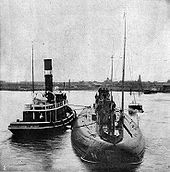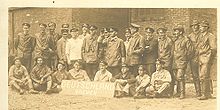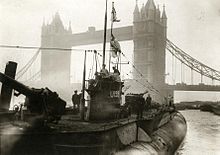- German submarine Deutschland
-

Deutschland unloading in New London, 1916.Career (German Empire) 
Name: Deutschland Port of registry: Bremen Ordered: 27 October 1915 Builder: Flensburger Schiffbau Launched: 28 March 1918 Fate: Converted into U-155 Career (German Empire) 
Name: U-155 Commissioned: 19 February 1917 Fate: Surrendered 24 November 1918. Broken up at Morecambe in 1922. General characteristics Class and type: German Type U 151 submarine Displacement: 2,272 tons Length: 65 m (213 ft) Beam: 8.9 m (29 ft) Draught: 5.3 m (17 ft) Propulsion: 800 hp Speed: Surfaced 15 kn (28 km/h; 17 mph)
submerged 7 kn (13 km/h; 8.1 mph)Range: 12,630 mi (20,330 km) Capacity: 700 tons Complement: 26 men[1] Armament: - 6 x bow torpedo tubes
- 2 x 150mm deck guns
Service record Part of: Kaiserliche Marine U-Kreuzer Flotilla
19 February 1917 – 14 November 1918Commanders: Karl Meusel
1917-02-19 – 1917-09-05
Erich Eckelmann
1917-09-06 – 1918-05-31
Ferdinand Studt
1918-06-01 – 1918-11-14Operations: 3 patrols Deutschland was a blockade-breaking German merchant submarine used during World War I. It was developed with private funds and operated by the North German Lloyd Line. She was one of the first of seven U-151 class U-boats built and one of only two used as unarmed cargo submarines.
After making two voyages as an unarmed merchantman, she was taken over by the German Imperial Navy on 19 February 1917 and converted into the U-155, armed with two torpedo tubes and a deck gun.
Contents
Construction
Deutschland was built together with her sister ship Bremen in 1916 by the Deutsche Ozean-Reederei, a private shipping company created for the enterprise, a subsidiary company of the North German Lloyd shipping company (now Hapag-Lloyd) and the Deutsche Bank.[2] She was constructed without armaments, with a wide beam to provide space for cargo. The cargo capacity was 700 tons (230 tons of rubber could be stored in the free-flooding spaces between the inner and outer hulls.[3]), relatively small compared to surface ships.
Deutschland was one of seven submarines designed to carry cargo between the United States and Germany in 1916, through the naval blockade of the Entente Powers. Mainly enforced by Great Britain's Royal Navy, the blockade had led to great difficulties for German companies in acquiring raw materials which could not be found in quantity within the German sphere of influence, and thus substantially hindered the German war effort.
Five of the submarine freighters were converted into long-range cruiser U-boats (U-kreuzers) equipped with two 150mm deck guns, and only two were completed according to the original design: the Deutschland and the Bremen, which was lost without a trace on her maiden voyage.
Britain and France soon protested against the use of submarines as merchant ships, arguing that they could not be stopped and inspected for munitions in the same manner as other cargo vessels. The US, under diplomatic pressure for supposedly showing favoritism while having declared itself neutral, rejected the argument. Even submarines, as long as they were unarmed, were to be regarded as merchant vessels and accordingly would be permitted to trade.[2]
Merchant service
First journey
Deutschland departed on her first voyage to the US on 23 June 1916 commanded by Paul König, formerly of the North German Lloyd company. She carried 750 tons of cargo in total, including 125 tons of highly sought-after chemical dyes, mainly Anthraquinone and Alizarine derivatives in highly concentrated form,[4] some of which were worth as much as $1,254 a pound in 2005 money. She also carried medical drugs, mainly Salvarsan, gemstones, and mail, her cargo being worth $1.5 million in total.[5]
Passing undetected through the English Channel[2] she arrived in Baltimore on 9 July 1916 (some sources say 7 July)[6] after just over two weeks at sea. A photograph by Karle Netzer dates the arrival 10 July ('erreichte Baltimore Hafen 10 Juli 1916'). During their stay in the US, the German crewmen were welcomed as celebrities for their astonishing journey and even taken to fancy dinners. American submarine pioneer Simon Lake visited the Deutschland while she was in Baltimore, and made an agreement with representatives of the North German Lloyd line to build cargo submarines in the US, a project which never came to fruition.[7]
She stayed at Baltimore until 2 August, when she sailed for Bremerhaven, arriving on 24 August with a cargo of 341 tons of nickel, 93 tons of tin, and 348 tons of crude rubber (257 tons of which were carried outside the pressure hull). Her cargo was valued at $17.5 million, several times the submarine's construction costs.[7] She had traveled 8,450 nmi (15,650 km; 9,720 mi), having been submerged for 190 nmi (350 km; 220 mi) of them.
Second journey
The Deutschland made another round trip in November 1916 to New London, Connecticut with $10 million of cargo including gems, securities, and medicinal products. At the same time the submarine U-53 also crossed the Atlantic to visit Newport, Rhode Island, and sank 5 Allied freighters just outside US territorial limits before returning home.
On 16 November as she was trying to put to sea, the Deutschland rammed and sank the tugboat T.A. Scott, Jr., with the loss of five men aboard the tug. Her bows were damaged, and she had to return to New London for repairs, which delayed her departure by a week.[8] She finally left New London on 21 November 1916, with a cargo that included 6.5 tons of silver bullion.
Following his last voyage, captain Paul König wrote a book (or possibly had it ghost-written) about the journeys of the Deutschland, entitled Voyage of the Deutschland, the First Merchant Submarine (Verlag Ullstein & Co, Berlin 1916). The book was heavily publicized, as it was intended to sway public opinion in both Germany and the US.[9]
War service
A third voyage, planned for January 1917, was aborted as German-US relations had worsened following the sinking of shipping bound for the United Kingdom, often just outside of US territorial waters. The Deutschland was taken over by the German Imperial Navy on 19 February 1917 and converted into the U-155, part of the U-Kreuzer Flotilla, being fitted with 6 bow torpedo tubes with 18 torpedoes, and two 150mm deck guns taken from the pre-dreadnought battleship SMS Zähringen.[3] She made three successful war cruises, sinking 42 ships and damaging one.[10]
1917
During the summer of 1917 U-155 made a 105-day cruise, commanded by Karl Meusel, leaving Germany around 24 May and returning on 4 September. During her traverse of the Northern Passage around the northern end of the British Isles and out into the Atlantic Ocean, she was stalked and nearly sunk by U-19 near Utsira Island, Norway.
During her patrol she sank 19 merchant ships, most by either scuttling or gunfire. She attacked 19 Allied armed merchantmen but only succeeded in sinking 9 of them. Upon her return to Germany she had covered a distance of 10,220 mi (16,450 km), of which 620 mi (1,000 km) had been travelled submerged, one of the longest voyages made by a U-boat during World War I.[11]
1918
U-155 sailed from Kiel on 11 August 1918 commanded by Ferdinand Studt. Studt's orders directed him to cruise off the US coast in the region of the Nantucket lightship and lay mines off St. John's, Newfoundland and Halifax, Nova Scotia. He was also directed to cut telegraph cables off Sable Island, 80 km (50 mi) southeast of Nova Scotia. His orders, however, proved problematic, and Studt came to believe that the St. Johns where he was to lay mines was actually Saint John, New Brunswick, in the Bay of Fundy.
On U-155's outbound voyage she had captured and scuttled the Portuguese sailing ship Gamo, had attempted an attack on the SS France, and destroyed by gunfire the Norwegian Stortind. On 7 September U-155 found herself in a long range gun duel with the US steamer Frank H. Buck, the steamer later claiming to have sunk U-155.
On 13 September U-155 engaged in another gun fight with the British merchantman Newby Hall which managed to damage the submarine, denting her armour and causing serious leaks in her pressure hull which made diving temporarily impossible.
On 19 September Studt tried and failed to locate and cut the telegraph cable near Sable Island then headed for Nantucket.[12]
Fate
U-155 returned to Germany from her final cruise on 12 November 1918 and was surrendered on 24 November 1918 with other submarines as part of the terms of the Armistice. She was taken to Britain and exhibited in London and elsewhere and was eventually sold for scrap in 1921. On 17 September 1921 she was being broken up at Robert Smith and Sons, Birkenhead, when an explosion ripped the ship apart, killing five apprentices.[13]
See also
- Italian R class submarine, World War 2, Italian cargo submarines
- Italian submarine Barbarigo, World War 2, Marcello-class submarine that was converted into a transport
- Italian submarine Luigi Torelli, World War 2, Marcello-class submarine that was converted into a transport
- Submarine Cargo Vessel, modern Russian cargo submarine proposal
Notes and references
- ^ Duncan, pp.71 & 73
- ^ a b c "Primary Documents: German Submarine Deutschland's Atlantic Crossing, 9 July 1916". FirstWorldWar.com. 8 November 2003. http://www.firstworldwar.com/source/deutschland1.htm.
- ^ a b Showell, Jak P. Mallman (2006). The U-boat century : German submarine warfare 1906–2006. Chatham Publishing. p. 81. ISBN 9781861762412.
- ^ "The Cargo of the Submarine "Deutschland"". Journal of the Chemical Society XXXV (23): 1202. 15 December 1916.
- ^ "The Submarine "Deutschland"". ColorantsHistory.org. http://www.colorantshistory.org/SubmarineDeutschland.html.
- ^ Gibson, p. 103
- ^ a b Polmar, Norman; Kenneth J. Moore (2004). Cold War Submarines. Brassey's. pp. 225. ISBN 1574885944.
- ^ "FIVE MEN DROWN AS DEUTSCHLAND CRASHES INTO TUG" (PDF). New York Times. 18 November 1916. http://query.nytimes.com/mem/archive-free/pdf?res=9C07E2D6143BE633A2575BC1A9679D946796D6CF.
- ^ Directed Readings on the U-Boat War – Blake, Sam, East Carolina University, April 2003.
- ^ U 155 (ex. Deutschland) WWI U-boats on uboat.net
- ^ Gibson, p. 217
- ^ Hadley, Michael L.; Roger Flynn Sarty (1991). Tin-pots and Pirate Ships. McGill-Queen's Press. pp. 244–245. ISBN 0773507787.
- ^ Paine, Lincoln P.; Hal Fessenden, James H. Terry (1997). Ships of the World: An Historical Encyclopedia. Houghton Mifflin Co.. pp. 140. ISBN 0395715563.
Bibliography
- König, Paul (2001). Voyage of the Deutschland, the First Merchant Submarine. US Naval Institute Press. ISBN 1557504245.
- Duncan, Francis (April 1965). "Deutschland – Merchant Submarine". Proceedings (Annapolis: United States Naval Institute): 68–75.
- Gibson, R.H.; Maurice Prendergast (2002). The German Submarine War 1914–1918. Periscope Publishing Ltd.. ISBN 1904381081.
- Uboat.net: U-boat Type U 151
External links
- Video: Merchant Submarine Deutschland arriving in Baltimore, 9 July, 1916.
- Video: Historic footage of submarine Deutschland departing New London, Connecticut, November 21, 1916, following repairs from tugboat collision.
German Type U 151 submarines Preceded by: Type U 142 – Followed by: Type UA Categories:- Type U 151 U-boats
- U-boats commissioned in 1916
- World War I submarines of Germany
- Cargo submarines
- World War I merchant ships of Germany
- U-boats commissioned in 1917
- 1917 ships
- Ships built in Flensburg
Wikimedia Foundation. 2010.



